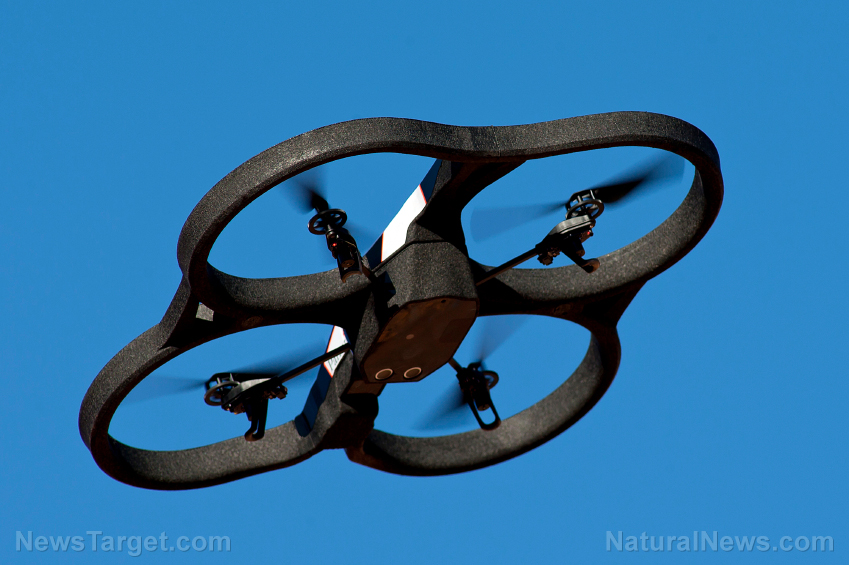Police in Colorado to start using DRONES to respond to 911 calls
06/04/2024 / By Ava Grace

Law enforcement agencies in Colorado intend to start using drones to respond to 911 calls.
“This really is the future of law enforcement at some point, whether we like it or not,” Sgt. Jeremiah Gates said, head of the drone program with the Arapahoe County Sheriff’s Office.
Currently, at least 20 agencies in Colorado’s mountainous Front Rage region utilize drone technology for specific tasks, such as searching for missing persons, tracking fleeing suspects, mapping crime scenes and providing aerial surveillance during SWAT operations. Now, the sheriff’s office is contemplating using drones to handle some 911 calls, providing valuable information from the scene before deploying officers. (Related: Report: U.S. military’s latest surveillance strategy involves TRACKING and LOCATING private citizens who express contrary opinions.)
Moreover, dispatching drones to less urgent calls could allow officers to focus on more critical situations.
“I could fly the drone over [a reported suspicious vehicle] and say, ‘Hey, that vehicle is not out of place,’ and I never had to send an officer over to bother them and I can clear it with that,” Gates explained. “It’s saving resources.”
Concerns raised over privacy and police transparency
Despite the potential benefits, Laura Moraff, a staff attorney for the American Civil Liberties Union (ACLU) of Colorado, expressed concerns about the implications of widespread drone usage by government agencies on individual freedoms.
“We’re worried about what it would mean if drones were really just all over the skies in Colorado,” Moraff said. “We are worried about what that would mean for First Amendment activities, for speech and organizing and protesting – because being surveilled by law enforcement, including by drones, can change the way people speak and protest.”
At the Denver Police Department (DPD), former Chief Robert White said no to drones in 2013 over constitutional concerns, and the department in 2018 shelved its sole drone, halting the program in Denver even as close to 20 metro police agencies embraced the unmanned aircraft.
The DPD already has a detailed, five-page policy on drone use, including a section on “Drones as a First Responder Program.” The short section notes that sending drones to calls before officers could help “tailor the response appropriately to avoid unnecessary escalation,” but doesn’t lay out how such a program would work.
It’s critical for law enforcement agencies to be transparent about how and when they use drones, and to listen to residents about what they want in a drone program, the ACLU’s Moraff said. She worries police departments will start using drones within set guardrails, but then secretly expand the use of the technology beyond what is legal or appropriate as drones become more ubiquitous.
“The cheaper this technology gets, and the easier it gets to deploy, the more risk there is that it will be used everywhere, and used in circumstances when it is not necessary,” she said.
The civil rights organization can see uses for drones in policing – particularly in response to specific, serious incidents, she said. But agencies must ensure they’re operating within the law.
“Safety and security are not just about reducing crime, prosecuting people and finding evidence,” Moraff said. “A truly safe community is one in which people are free to express their views, to organize together and live their lives without unjustified government intrusion.”
Watch this video discussing Denver’s plan to deploy drones for 911 calls and how it might herald the end to traditional policing.
This video is from the Daily Videos channel on Brighteon.com.
More related stories:
Amazon begins testing drone delivery of medications in Texas.
U.S. drone forced to make an emergency landing in Poland; Russian GPS jamming weapon blamed.
California thieves NOT BOTHERED at all by surveillance cameras.
Sources include:
Submit a correction >>
Tagged Under:
big government, Colorado, computing, cyborg, Denver, Denver Police Department, drones, future tech, Glitch, information technology, inventions, national security, Police, police drones, police state, policing, privacy, robotics, robots, surveillance, transparency
This article may contain statements that reflect the opinion of the author
RECENT NEWS & ARTICLES
COPYRIGHT © 2017 INFORMATIONTECHNOLOGY.NEWS




















